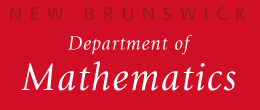Nature of the Course
Math 136 is the second semester of the Math 135-136 sequence for students studying Life Sciences or Social Sciences. Math 136 is designed specifically for students who want a second semester of calculus for their technical background, but who do not intend to take further courses in Calculus or Differential Equations. Therefore, Math 136 offers a mixture of traditional Calculus II topics and of additional topics—such as mulitivariate functions and constrained optimization using Lagrange multipliers—that students are likely to meet in scientific applications.
Life Sciences majors may also take Math 138 to fulfill their requirement of a second semester Calculus course. To decide which course they would prefer, Life Sciences majors should also visit the Math 138 web page.
To include the additional material described above, Math 136 excludes many topics that are needed in a third semester calculus course such as Math 251. For this reason, Math 136 is not a CALC2 equivalent course. That is, Math 136 will not serve as a prerequisite for Math 251 or any other course requiring a CALC2 prerequisite, except Math 250. The same applies to Math 138.
Math 136 is not a CALC2 equivalent course.
The only courses satisfying the CALC2 prerequisite are
- Math 152, 154, and 192*
In summary:
If you intend to take higher level courses requiring CALC2, do not take Math 136 or Math 138; take Math 152 instead.
Text and Syllabus
Here is the current departmental syllabus for the course. Your instructor will supply his or her own version of this syllabus.
Fall 2019 Schedule
*Note: Through Fall 2001 Math 136 followed a syllabus similar to the Math 152 syllabus and was accepted as an equivalent for CALC II.
Previous semesters
|
|
|
Earlier Text (used from Spring 2004 to Spring 2014)
with this Syllabus:
Strauss, Bradley, Smith; Calculus Prentice Hall
Text used from Spring 2001 to Fall 2003,
with this Syllabus:
Soo T. Tan; Applied Calculus; Brooks/Cole (Fifth edition),
2002 (976 pp.);
Disclaimer: Posted for informational purposes only
This material is posted by the faculty of the Mathematics Department at Rutgers New Brunswick for informational purposes. While we try to maintain it, information may not be current or may not apply to individual sections. The authority for content, textbook, syllabus, and grading policy lies with the current instructor.
Information posted prior to the beginning of the semester is frequently tentative, or based on previous semesters. Textbooks should not be purchased until confirmed with the instructor. For generally reliable textbook information—with the exception of sections with an alphabetic code like H1 or T1, and topics courses (197,395,495)—see the textbook list.








